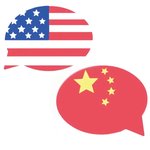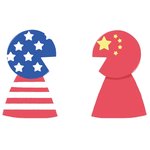





Editor’s note: Journalism professor Buck Ryan in Kentucky and English lecturer Lei Jiao in Wuhan, China, pursue cross-cultural understanding through good stories — this time how emojis with exceptional design led to their induction into the Smithsonian.
BUCK: Lei, it all started with a Chinese dumpling.
LEI: Stop, Buck, you’re making me hungry.
BUCK: Well, that was the story for two Chinese-ish women trying to punctuate their texts to say they were dying for dumplings.
LEI: “-ish”?
BUCK: That was their term. I know you’re red-blooded Chinese — I guess these women felt a little pink.
LEI: Aw, Buck, if only we had an emoji to end that sentence. I see three for “pin” — a safety pin, a push pin and a map locator pin — but nothing for “pink,” or kind of Chinese.
BUCK: That’s the whole point! These heroic women made it their mission in 2015 to have a dumpling emoji added to the list of internationally approved visual punctuation.
LEI: You’re kidding.
BUCK: No, and we’re going to do the same thing, Lei Jiao. Get your daughter, Ruby, on the horn. We need an artist, fast!
LEI: Whoa, Buck Ryan. Ruby is a busy girl. You’ll have to tell me more about your madcap scheme. What’re you thinking?
BUCK: Well, Lei, this is something I’ve been thinking about for a long time — maybe 14 years now — ever since I interviewed Hal Saunders for a documentary about China, “Citizen Kentucky/Citizen China: Hope for a New Century” (KET, 2008).
LEI: Who’s Mr. Saunders?
BUCK: Harold H. Saunders served in the U.S. State Department under six presidents. He worked on the Camp David Peace Accords between Israel and Egypt in 1978, negotiated to get American hostages released from Iran in 1981, but his China connection might intrigue you more.
LEI: Oh?
BUCK: He acted as a decoy for Henry Kissinger to keep the press off his trail as Kissinger made his secret trip to China in 1971.
LEI: Ha! Nothing to see here — just cracking the Cold War ice.
BUCK: Right, Lei. Over the years, Hal would do a 180 on how he viewed “normalizing” relations between the U.S and China.
LEI: Huh.
BUCK: As Hal told me, once U.S.-China relations were determined by only four men—Nixon and Kissinger and Mao and Zhou. Now those relations are shaped by citizen-to-citizen interactions, which have power beyond government policy.
LEI: That’s a radically profound notion, Buck.
BUCK: Yes, Lei, enough to humble any control freak. You can learn more from Hal’s book, “Politics Is About Relationship: A Worldview for the Citizens’ Century” (revised 2014).
LEI: I wonder what Henry Kissinger thinks about that?
BUCK: Well, he and former President Jimmy Carter wrote positive blurbs for Hal’s first edition in 2005. It outlined how concerned citizens outside government can bring about social change.
LEI: So why am I calling Ruby?
BUCK: We need an emoji for that!
LEI: For what?
BUCK: Something to express a notion as tasty as a Chinese dumpling—the power of citizen-to-citizen interactions to change the world.
LEI: Right.
BUCK: As the rhetoric gets hotter between our governments, we need to put “the People” back in “We the People” and “the People’s Republic of China.” Only an emoji can save us now!
LEI: That’s a radically insane notion, Buck.
BUCK: Aw come on, Lei. We can change the world one emoji at a time. Think of the power.
LEI: What power?
BUCK: The power to communicate clearly! Do you know what the word “emoji” means?
LEI: It’s Japanese, right?
BUCK: Yes, for “picture character.” And do you know what Oxford Dictionaries announced as the 2015 Word of the Year?
LEI: No, what?
BUCK: The “face with tears of joy” emoji—not a word at all.
LEI: You’re making me laugh until I cry, Buck.
BUCK: Seriously, Lei. I guess you missed the first Emoji Spelling Bee, eh?
LEI: When was that?
BUCK: The next year, 2016, in San Francisco. The prize was awarded by Finland’s director of public diplomacy, who helped to launch her nation’s official emoji. It’s not too late to catch the wave, Lei!
LEI: Buck, you’re killing me. Get serious.
BUCK: OK, Lei, imagine I text you, “The police are here.” What happens?
LEI: I would start to get anxious and worry something bad happened to you.
BUCK: Right, Lei. Then comes something magical: I end the text with a smiley face emoji. Poof! All that anxiety disappears, right?
LEI: Right.
BUCK: We’re living on the edge, Lei. It’s a digital world of nuance. Goodbye, face-to-face communication — hello, virtual exchanges.
LEI: I see that.
BUCK: Tone of voice and meaning gets lost. We are so easily misunderstood! Emojis can help us get our points across clearly.
LEI: So where did you get that idea?
BUCK: From listening to “Sidedoor: A Podcast from the Smithsonian,” with support from Public Radio Exchange, or PRX. I stumbled on an old episode entitled “Love in the Time of Emoji.”
LEI: Smithsonian?
BUCK: Yes, every once in a while a new emoji is so elegantly designed that it makes its way into the Cooper Hewitt Smithsonian Design Museum in New York City.
LEI: Like what?
BUCK: Well, according to the museum’s website, “In 2020, Cooper Hewitt acquired the Person with Headscarf and the Inter-skintone Couple emoji for the museum’s permanent collection.”
LEI: And you think a Buck-Lei emoji is next?
BUCK: Yes!
LEI: Buck, you’re crazy.
BUCK: We can do it, Lei. We’re not alone.
LEI: Oh?
BUCK: Enter Emojination! Its motto is “Emoji By The People, For The People: We give voice to the people about emojis.”
LEI: Really.
BUCK: Yes, Emojination can help us. It wants to make emoji approval “an inclusive, representative process.”
LEI: We’ll need a real fighter with a lot of luck on our side.
BUCK: Got someone in mind! Emojination’s co-founder, Jennifer 8. Lee, a film producer, author and journalist.
LEI: Well that middle initial is a lucky number in China.
BUCK: Lee explained on the podcast how she raised money, maybe $21,000, to buy a seat at the table to get the dumpling emoji approved.
LEI: What table?
BUCK: The Unicode Consortium, a non-profit corporation that develops standards for characters. So if I send you a heart from the U.S., it doesn’t show up as googly-eyed poop in China.
LEI: Buck, you’re making my head hurt. This sounds impossible. How long will it take?
BUCK: If we’re lucky, our emoji would be available to writers around the globe in 18 months. It’s a byzantine approval process.
LEI: See?
BUCK: No time to waste, Lei!
LEI: Tell me again, how can Lee help us?
BUCK: She learned a lot as vice chair of the Unicode Emoji Subcommittee. Emojination celebrated worldwide success with its campaigns for the hijab emoji and the dumpling emoji.
LEI: You’re making me hungry again, Buck.
BUCK: This will be Ruby’s greatest challenge! Not since taking the Zhongkao standardized exam will she conquer such a hill.
LEI: Buck, you’re asking the kid to climb Mt. Everest. OK, I’ll ask her.
BUCK: Thanks, Lei. Just let me know what she thinks.
LEI: Buck, I got your answer. Ruby is game on one condition.
BUCK: What’s that?
LEI: When she’s finished, we go out for dumplings.
Let us know which one of these Buck-Lei emojis, drawn by Lei Jiao’s daughter, Ruby, is your favorite. Or maybe you have a better idea. Join the fun! Cast your vote or submit your entry to the News + Record Emoji Contest. Send us a note to emoji@chathamnr.com.
About the authors: Buck Ryan, a University of Kentucky journalism professor, and Lei Jiao, an English lecturer at Wuhan University of Technology, Hubei Province, China, collaborate on articles to advance cross-cultural understanding.
You can read their two-part series on U.S.-China relations, first “A new Cold War recipe: Take China’s overconfidence, add our misperceptions, then dip it in a batter of ‘strategic ambiguity’” at this link:
https://chathamnewsrecord.com/stories/a-new-cold-war-recipe-take-chinas-overconfidence-add-our-misperceptions-then-dip-it-in-a,13488
Then “Misperception, the real enemy, wins as saber-rattling over China drowns out people-to-people exchanges” here:
https://www.chathamnewsrecord.com/stories/misperception-the-real-enemy-wins-as-saber-rattling-over-china-drowns-out-people-to-people,13668